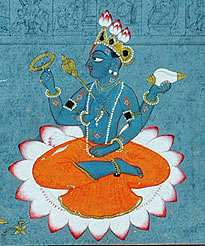Gopala Bhatta Goswami
| Part of a series on |
| Vaishnavism |
|---|
 |
|
Sampradayas |
|
Philosophers–acharyas |
|
Related traditions |
|
|
Gopala Bhatta Goswami (1503–1578) is one of the foremost disciples of the Vaishnava saint, Chaitanya Mahaprabhu, and a leading historical figure in the Gaudiya Vaishnava school of Hinduism. He was part of a group of Vaishnava devotees known collectively as the Six Goswamis of Vrindavan, who were influential in establishing the philosophical basis of the Gaudiya tradition in formalised writings.[1]
Background
According to biographies such as the Bhakti Ratnakara Gopal Bhatta's first meeting with Shri Chaitanya Mahaprabhu was in 1510 during Mahaprabhu's tour of South India. Although of a young age he was given the opportunity to meet with Chaitanya and serve him over a number of months. Such was his love for the saint, that when Chaitanya Mahaprabhu was about to leave, Gopala Bhatta became upset, and for Gopala Bhatta's sake, Chaitanya then agreed to stay a few more days.
According to Gaudiya tradition it was during this time that Gopala Bhatta had a spiritual vision in which Chaitanya Mahaprabhu revealed Himself as an avatar of Krishna, the supreme God. In the vision Krishna then told him that in the town of Vrindavan he would meet with two devotees, namely Rupa Goswami and Sanatana Goswami who would instruct him in the finer details of devotional service (bhakti).
When Gopala Bhatta awoke from the experience, he wanted to leave for Vrindavan at once, however Chaitanya Mahaprabhu told him to stay and serve his parents. After Chaitanya's departure, Gopal Bhatta took guidance from his uncle Prabhodananda Sarasvati. Gopal Bhatta took care of his parents into their old age, and then after they died he then traveled to Vrindavana. There he met Rupa and Sanatana who accepted him as a brother. Gopal Bhatta later helped Sanatana compile the book Hari Bhakti Vilasa.
Vrindavan

Gopala Bhatta studied rhetoric, poetry, Vedanta, and Sanskrit grammar from his uncle Prabodhananda Sarasvati. After the passing of his parents he went to Vrindavan, where he met both Rupa and Sanatana Goswamis as had purportedly been instructed in his vision.
When Lord Chaitanya discovered that Gopala Bhatta was in Vrindavan, he was extremely pleased and sent some of his personal belongings to Gopala Bhatta, who worshiped them. Mahaprabhu also sent a letter instructing Gopala Bhatta to help Rupa and Sanatana compile Vaishnava literature. Gopala Bhatta accepted this instruction as his life and soul, and he later also engaged his disciple Srinivasa Acarya in carrying the writings to Bengal. Gopala Bhatta established the Radha Raman Temple in Vrindavan in 1542, his samadhi also exists within the temple complex.[2]
See also
- Bhakti Yoga
- Hare Krishna (mantra)
- Nityananda
- Gaudiya Math
- International Society for Krishna Consciousness
- Krishnology
- Narasingha Caitanya Ashram http://gosai.com/
References
- ↑ "Gopala Bhatta Goswami". Gaudiya History. Archived from the original on 14 October 2014. Retrieved 12 October 2014.
- ↑ Property Vrindavan - Radha Ramana Temple
Bibliography
- Bhakti Ratnakara (PDF).
- Shri Narahari Chakravarti (1913). Shri Rasabihari Sankhya Tirtha, ed. Bhakti Ratnakar (in Bengali). Shri Ramdev Mishra.
External links
- Gopala Bhatta Goswami (radhakunda.com)
- The History of Sri Radha Raman Temple, Vrindavan